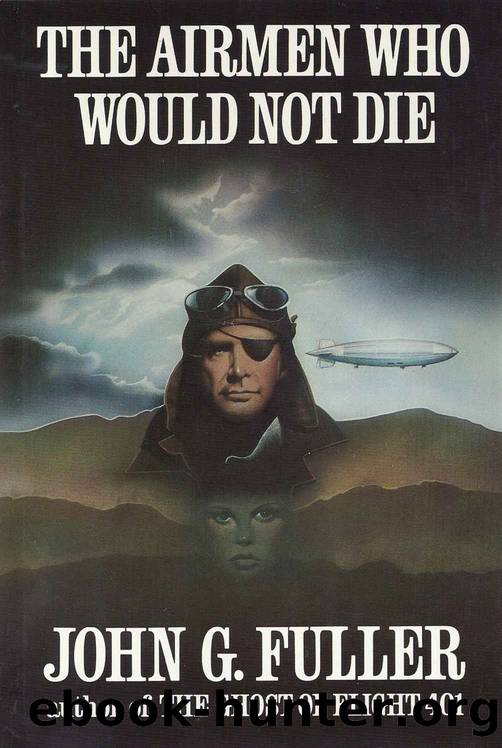The Airmen Who Would Not Die by Fuller John G

Author:Fuller, John G. [Fuller, John G.]
Language: eng
Format: epub
ISBN: 978-0-399-12264-4
Publisher: BookBaby
Published: 2014-01-29T00:00:00+00:00
In addition to the officers directly under the command of Flight Lieutenant Irwin, captain of the ship for the India trip, Wing Commander Colmore, Major Scott and designer Richmond would theoretically have no command positions. They would represent the Royal Airship Works as senior directors of the project. Captain Irwin would command the five officers responsible for running the ship, which included Navigator Johnston and the half-reluctant Atherstone. There would be five coxswains aboard to handle the rudder and elevator controls, along with nine riggers, eighteen engineers, four wireless operators, three stewards and a galley boy. The entire list would total fifty-four passengers, officers and crew.
The critical point on everyoneâs mind was weather. At 9:30 that morning, Captain Irwin, Major Scott, and the shipâs special meteorologist named Giblett, all met in the Forecast room at the Meteorological Office at Cardington. The weather didnât look too bad. There was a shallow depression near Tynemouth in England moving northeast, and another front moving eastward over Europe. It even looked as if the weather would improve, with perhaps just broken clouds by evening.
But by 3:00 in the afternoon, the situation had deteriorated. A trough of low pressure off western Ireland was spreading rapidly. Rain would come in from the west, probably reaching Cardington by evening. Clouds would drop down to about 1,000 feet, visibility might range from 2 to 6 miles, and in northern France there would be rain and winds up to 20 to 30 miles an hour from the southwest. It was not an ideal picture. Neither was it a hopeless one. No great increase in the velocity of the winds was expected, which was encouraging. Scott and Irwin thought they could handle it, and went ahead with preparing the ship. The barometer, however, was falling.
In spite of the pending adventure, Sir Sefton Brancker had scheduled one of his usual hectic days. He was to visit the busy aeroport in Lympne, down in the Kentish hunting countryside near the channel. Then he was to fly to Norwich, up in Norfolk, inland from Great Yarmouth on the eastern coast. After that he would make his way to Cardington in time for the historic flight. He would have little time to chew monocles or wilt collars on this day.
He could not be flown directly to Cardington, because no planes were permitted to land or fly within three miles of the R-101 when she was at her mast. He could, however, fly to Henlow, barely 20 miles south of Cardington, where Major Villiers volunteered to pick him up. Whatâs more, Villiers could bring Sir Seftonâs books and topeeâthe sun helmet associated with mad dogs and English men in the blistering heat of India. Branckerâs main luggage had already left his club in Mayfair, to be pre-boarded before he arrived.
His plans arranged, a well-known woman pilot named Winifred Spooner flew him from Croydon down to Lympne, where he had a consultation scheduled with Lieutenant Commander Deacon, the aerodrome officer in charge.
The first thing that struck Deacon was that âBrancksâ was not his old vivacious self.
Download
This site does not store any files on its server. We only index and link to content provided by other sites. Please contact the content providers to delete copyright contents if any and email us, we'll remove relevant links or contents immediately.
The Compleat Magical Path Magic Lessons by John Cross(401)
The Return of the Dragon : The Shocking Way Drugs and Religion Shape People and Societies by Lewis Ungit(381)
THEM: They Come at Night by Tom Lyons(373)
Dogme et Rituel de la Haute Magie Part I by Eliphas Levi(359)
The Mind at Large: Clairvoyance, Psychics, Police and Life after Death: A Polish Perspective by Weaver Zofia & Janoszka Krzysztof(354)
The Bonds That Bind by K. J. Lavallee(350)
Strange Tricks by Syd Moore(348)
Shaman: The Mysterious Life and Impeccable Death of Carlos Castaneda by Mike Sager(342)
The Iron Republic by Richard Jameson Morgan(340)
101 Ways to Jump-Start Your Intuition by John Holland(335)
Psychic Secrets by Jade-Sky(332)
Haunted Ships: True Paranormal Ghost Ship Stories by Press Chronicle(327)
Kabbalah and Sex Magic by Marla Segol(325)
Cult Cinema: A Personal Exploration of Sects, Brainwashing and Bad Religion in Film and Television by Ingham Howard(324)
Kickstart My Witch (Witch's Guide to Haunted Properties: Los Angeles: Mystery Book 1) by Lotta Smith(311)
Evil Unleashed: True Tales of Spells Gone to Hell and Other Occult Disasters by John Harker(308)
The Satanism Scare by Joel Best(305)
The Blood Electric: Nephilim Unbound 5 by Jason Caldwell(305)
The Airmen Who Would Not Die by Fuller John G(297)
